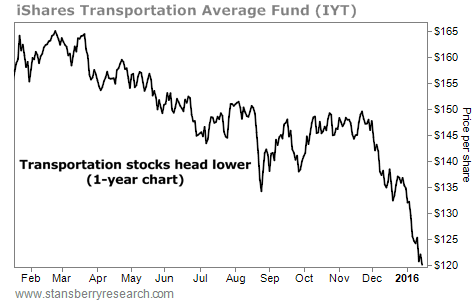| Home | About Us | Resources | Archive | Free Reports | Market Window |
|
Editor's note: Today, we're continuing our special series from Dr. David "Doc" Eifrig. Yesterday, Doc showed you the power of options trading and explained how to become a stock market landlord... In today's essay, he details another opportunity in what he calls "Digital Utilities." If you're looking to earn safe income in today's volatile market, you can't afford to miss this essay...
Earn Safe 15%-Plus Income With 'Digital Utilities'By
Tuesday, January 19, 2016
Today, investors have an incredible opportunity to earn double-digit percentage rates of income.
You simply have to look past conventional investments like bonds and mutual funds...
You have to look at unusual income plans like "Digital Utilities." As I'll show you today, this plan is paying out safe income streams of at least 15%.
Traditional utility stocks have been a good friend to retirees and other income investors for generations.
You see, if you want indoor plumbing or a refrigerator, you have to do business with the municipal utility company. In many cities, these utility companies enjoy monopoly positions. The government-guaranteed profit turns these companies into income-producing machines. Because everyone has to use their services, the payments they deliver to shareholders are secure and safe.
These traditional utilities still have a place in the retiree's portfolio. But as longtime DailyWealth readers know, there's an alternative type of utility company you should consider...
These stocks are safe. They enjoy near-monopoly positions. And if you're willing to try something a little different, you can collect annual income payments nearly four times as large as what you'll get with traditional utilities.
Let me explain...
"Digital Utilities" is the name I've given to certain dominant "Big Tech" companies. I'm talking about names like Intel (INTC) and Microsoft (MSFT). Intel dominates the semiconductor industry. Microsoft dominates the software industry. Just like you can't turn the light on without using power from your electrical utility, you can hardly use a computer without using these companies' products. And because Digital Utilities don't have to contend with nearly as much regulation as traditional utilities, they can growth their profits much faster. These companies have all the makings of a perfect utility:
Just like regular utilities, Digital Utilities pay reliable dividends in the 3%-4% range. But right now, you have an opportunity to quadruple the amount of income you collect from these stocks... without taking on any additional risk. That opportunity is selling put options.
The process is different from just buying shares. And it takes a little while to get used to the idea. But don't worry, it's safe. Done right, it's a great income-generating strategy, as well as an opportunity to lower the cost of buying stock you're willing to buy anyway.
Let me show you how it works using an example you're probably familiar with...
When you insure your home, you are essentially buying the right to sell your house to the insurance company for a certain value, under certain conditions, for a limited period of time. In return, you pay the insurance company to accept those terms – whether or not you ever exercise the terms of the policy.
Put options work the same way. When you sell a put option, you're acting like the insurance company. You're agreeing to buy someone else's shares of a particular stock for a set price, under certain conditions, for a limited period of time.
In the case of your house, you'd exercise your policy in a disaster... when a fire or catastrophic weather damage wrecks the value of your home. In the case of a put option, the holder would exercise his right to sell us his stock if the market value of his shares falls below the price we agreed to pay.
I've shown thousands of readers how to do it in my Retirement Trader advisory. Once you get the hang of it, it will change the way you see income investing.
Let me walk you through some numbers, so you can see how useful a tool this is if you're looking for safe income...
Right now, Microsoft trades for about $51 per share. Let's say you sell someone the right to sell you their shares for $50 each ($5,000 total – one contract covers 100 shares) at any time between now and mid-April. You collect $250 for selling that right. This $250 payment represents an instant 5% yield on the money you may have to pay for shares.
If Microsoft stays above $50 in April, then the put buyer won't want to sell to you for $50. The option will expire. You won't have to do anything, and you keep the instant $250. All told, you'll walk away with 5% on your capital in three months – that's 20% annualized.
If Microsoft does not stay above $50, you keep that $250 and you'll have to buy 100 shares of Microsoft for $5,000. That puts your cost at $4,750 total, or $47.50 per share – a 7% discount to today's prices. You can then hold those shares, collecting dividends and a capital gain if shares rise.
That's the most important factor to remember when selling put options: Only sell puts on stocks that you actually want to own.
Readers who have followed my advice over the past couple of years have been able to do just that. They've been able to turn a safe "utility" stock into 15% a year or more in income.
That's about four times what you can collect by simply owning shares.
Don't get me wrong... Regular shareholders of traditional utility stocks and "Digital Utility" stocks like Intel and Microsoft will do just fine over the coming years. Both investments will pay out reliable dividends.
But folks who are willing to do a bit more work can start earning 15%-20% a year right now.
Here's to our health, wealth, and a great retirement,
Dr. David Eifrig
Further Reading:
Selling puts is a simple way to generate income and potentially "buy" the stocks you want to own, at the exact price you want to pay, while minimizing risk and greatly increasing potential returns. Learn more about selling puts in this interview with Doc.
"Utility stocks now look like a better deal than they have been in nearly a decade," Doc says. Adding utility stocks to your portfolio is a great defensive move for 2016. Learn more about this idea in this essay from last week.
Market NotesTHIS SECTOR'S DOWNFALL SPELLS TROUBLE Today's chart is a concerning look at the economically sensitive U.S. transportation sector.
Transportation stocks are among the first sectors to lead the market up or down. And while you might think low oil prices would mean added profits for these stocks, many companies in the sector – including railroads – have struggled.
To see this trend at work, we turn to the iShares Transportation Average Fund (IYT). This fund holds a basket of important railroad firms, trucking companies, airlines, and other transportation stocks. As you can see below, the sector is really hurting right now.
While the overall market is down 6% over the past year, shares of IYT are down 23% and just hit a new 52-week low. It's one of the important sectors leading the market lower right now... and it's a good reminder to be cautious.
 |
Recent Articles
|



